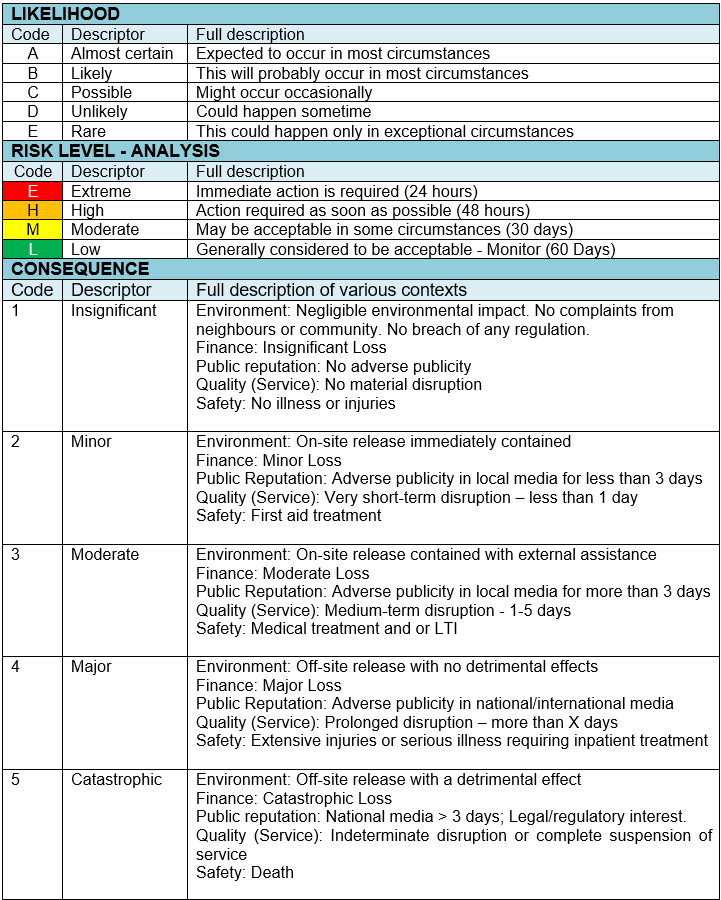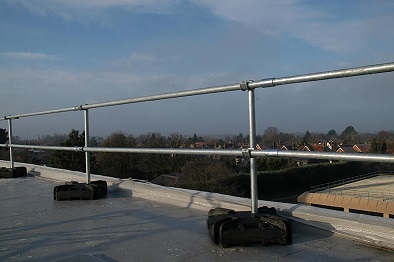Title Page
-
Risk Assessments Require two or more people to perform, at a minimum one being a company representative (Forman or above) and at least one worker who is to perform the task. A WHS Department rep and Safety Rep should also read, understand, and agree that all Hazards and Controls have been identified within each assessor's knowledge (Including themselves) and signed off on the assessment. All workers who will be at Risk from the Hazards are made aware of them and the Controls expected and then Sign Off on this risk assessment. The Hazards and Controls assessed in this Risk Assessment can then be used in the development of a SWMS to be prepared and used for work activities that are carried out on a regular basis. Prior to each new activity, the SWMS must be reviewed and revised to ensure it applies to the high-risk construction work and the actual workplace. If this is your first time performing a Risk Assessment, read the attached PDF "Risk Assessment Procedure" for guidance.
-
Site
-
Conducted on
-
Prepared by (Full Name and Signature Required
Risk Matrix
Matrix
-
Use the below Risk Matrix to determine Risk Levels throughout the Risk Assessment
-
Matrix
-
Risk Assessment
-
Nature of work
-
Picture of work area including product/plant/machinery etc. being worked on
Identification of Work at Heights Activities
-
Are there activities associated with working at heights?
-
Select activities
- Installing Parts - Fitting
- Welding at Height
- Dismantling machinery
- Working under the ceiling in the factory/workshop
- Painting at heights
- Other
- Maintenance
-
List other activities in the area involving working at heights
-
Are the employees / contractors / members of public at risk from work at height identified?
-
Frequency of performing these activities
Identification of Hazards
-
Employee falling from height
-
Employee falling through a fragile roof
-
Objects falling on workers/members of the public
-
Slipping / collapsing access equipment
-
Slips / trips on elevated access ways
-
Other
Risk Level from the Hazards
-
What is the Highest Risk Level from the Hazards
Control Measures
PLANNING
-
Is working at heights avoided where possible?
-
Is work at heights properly planned and organised?
-
How?
-
Has the work area been surveyed for hazards, eg overhead dangers, unsuitable ground conditions, and moving machinery parts?
-
During work at height is there always a competent person present who can suspend work if conditions change, eg weather, traffic, scope of work?
FRAGILE ROOFS - Work on roofs should only be carried out by experienced contractors working off their own SWMS
-
Are fragile roofs identified, labelled especially where fragility is disguised?
-
Are warning signs fixed on the approach to fragile roofs?
-
Is unauthorized access to roofs / roof spaces prevented?
ACCESS EQUIPMENT - Scissor Lifts - Platform Ladders
-
Are platform ladders, scissor lifts, safety steps and all other access equipment regularly inspected?
-
Are platform ladders only used for light work of short duration?
-
Are scissor lifts used where possible for work over 2m?
-
Are work platforms sufficiently wide to walk on without risk of stumbling or losing balance?
-
Are work platforms capable of supporting workers, equipment, materials, the safe working loads indicated and inspected every six months?
-
Is there a log maintained for ensuring the quality of this equipment?
OPEN EDGES
-
Are open vertical drops identified and properly guarded when open?
-
Are hand rails present on the open side of staircases?
-
Are measures always taken to prevent falling objects injuring others as a result of working at heights?
-
Is fixed edge protection provided to prevent falls where working at heights cannot be avoided?
-
REFERENCE: Edge protection installed properly
[This is an example of how you can use iAuditor to include best practice reference images in your templates to assist with inspections]
RACKING
-
Is storage properly planned which discourages climbing racking or pallets to access parts?
-
Are adequate provisions in place to allow safe access to stored parts?
TRAINING
-
Have all workers who work at heights been assessed as competent or closely supervised by someone who is competent?
CONTRACTORS
-
Do contractors provide safe written working procedures for work at heights, are they screened / instructed and is their work monitored by a competent person?
PROTECTIVE EQUIPMENT
-
Where the risk of falls cannot be eliminated are safety harnesses, fall arrest devices or safety nets used as required?
-
Are anchorage points for safety harnesses provided, used and regularly inspected?
-
Are any other Protective measures used including PPE (Think steel cap boots being checked for good grip)?
Risk Level after Controls
-
What is the overall Risk Level after all Controls are in place?
-
Write down any positive observations
Recommendations
-
List recommendations for improvements here (set an action to the WHS Department to suggest an improvement)
Rescue Plan
-
Is there a minimum of two persons who are trained in height rescue available in the work zone, not working at heights and easily contactable in the case of a worker falling?
-
If two trained persons in height rescue are not available then the work can not continue until training is done, read the required training document attached here.
Completion
-
By Signing this Working at Heights Risk Assessment, you are maintaining that you understand the Hazards involved and will follow the Controls to reduce the Risk of a Fall from Heights.
-
Full Name and Signature of Production Manager
-
Full Name and Signature of Foreman
-
Full Name and Signature of Safety Rep
-
Full Name and Signature of WHS Department Rep or General Manager
-
Full Name and Signature of Leading Hand
-
Full Name and Signature of Leading Hand
-
Full Name and Signature of Worker
-
Full Name and Signature of Worker
-
Full Name and Signature of Worker
-
Full Name and Signature of Worker
-
Full Name and Signature of Worker
-
Full Name and Signature of Worker
-
Full Name and Signature of Worker
-
Full Name and Signature of Worker
-
Full Name and Signature of Worker
-
Full Name and Signature of Worker
-
Full Name and Signature of Worker
-
Full Name and Signature of Worker
-
Full Name and Signature of Worker
-
Full Name and Signature of Worker
-
Full Name and Signature of Worker
-
Full Name and Signature of Worker
-
Full Name and Signature of Worker
-
Full Name and Signature of Worker
-
Full Name and Signature of Worker
-
Full Name and Signature of Worker
-
Full Name and Signature of Worker
-
Full Name and Signature of Worker
-
Full Name and Signature of Worker
-
Full Name and Signature of Worker
-
Full Name and Signature of Worker
-
Full Name and Signature of Worker
-
Full Name and Signature of Worker
-
Full Name and Signature of Worker
-
Full Name and Signature of Worker
-
Full Name and Signature of Worker
-
Full Name and Signature of Worker
-
Full Name and Signature of Worker
-
Full Name and Signature of Worker
-
Full Name and Signature of Worker
-
Full Name and Signature of Worker
-
Full Name and Signature of Worker
-
Full Name and Signature of Worker
-
Full Name and Signature of Worker
-
Full Name and Signature of Worker
-
Full Name and Signature of Worker
-
Full Name and Signature of Worker
-
Full Name and Signature of Worker
-
Full Name and Signature of Worker
-
Full Name and Signature of Worker
-
Full Name and Signature of Worker
-
Full Name and Signature of Worker
-
Full Name and Signature of Worker
-
Full Name and Signature of Worker
-
Full Name and Signature of Worker
-
Full Name and Signature of Worker












